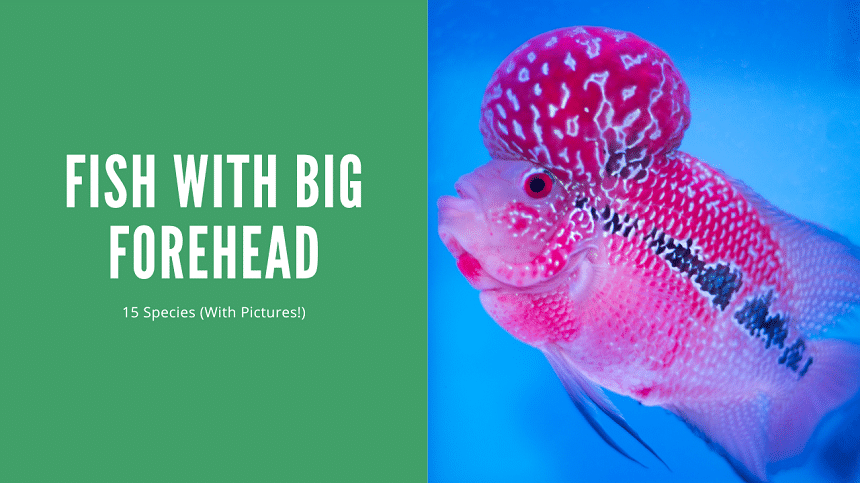Thank you for visiting! By the way… any links on this page that lead to products on Amazon and other stores/partners are affiliate links Aquarium Store Depot earns a commission if you make a purchase.
No, fish with big foreheads are not smarter than fish with small foreheads. Instead, big foreheads can be used to attract mates, deter competitors, avoid predators, and even provide internal benefits to the fish. At the same time, these evolutions can make for some strange-looking fish!
Here are some of the most notable fish with big forehead features and the reasons they might have evolved to look the way they do.
Key Takeaways
- Many freshwater and saltwater fish have modified facial structures that appear as a large bump or hump on the top of their head.
- Male individuals are much more likely to have these humps, but females may also have smaller head features.
- Big foreheads may be used for mating, defense, and foraging for food.
- Studies are being made to understand why fish and other marine life have large heads, like for echolocation and physiological process.
Face Morphology
A lot can be determined by simply looking at the face of a fish. Notice the eyes, the mouth, the teeth, and the barbels if they’re present. Every feature of a fish’s morphology evolved to help the fish in one way or another; in some cases, these features, mostly eyes, disappear altogether to allot resources to more important functions!
One morphology that has evolved in fish is the nuchal hump1. The nuchal hump is an often large bump on top of the fish’s head. This feature is mostly present in freshwater cichlids but can be seen in some marine species as well. It’s important to note that not all fish with big foreheads have a nuchal hump.
Why did fish evolve to have this morphology?
It seems that most fish with big foreheads use their structures for the same reasons: mating, defense, and foraging as well as some other possible physiological benefits. Still, the overall uses and advantages of these structures are being closely studied across species.
Mating
Like most animals, fish use body modifications to attract mates. This may be through intense coloration or specialized structures, such as a big forehead. Most saltwater and freshwater fish individuals that exhibit a large head are male (like the humphead glassfish). Female fish might have a smaller bump or lack one altogether.
Male fish with big foreheads are most likely to be physically fit, meaning that they have good genes that are ideal to be passed down to future generations. A female will see this and be much more likely to mate with a male with a big forehead than a smaller one. To help bring attention to this, the bump is usually brightly colored as well.
Defense
Fish with big foreheads may also use their structures to defend themselves and their resources. Similar to animals on land, headbutting behaviors have been observed in some species. Most times, though, fish try to settle disagreements without getting physical, as this could potentially cause injury to both parties.
Instead, a fish with a big forehead might first try to intimidate other fish with smaller foreheads. This may be through sheer size alone or certain movements or colors that help enhance the size of the forehead.
Foraging
Another way fish with big forehead modifications use their heads is by searching for food. One specific example is the green humphead parrotfish (Bolbometopon muricatum). These are large saltwater fish that live and feed among coral reefs throughout the Pacific and Indian Oceans. In addition to their strong beaked mouth, these fish dislodge and eat coral by ramming their heads into the reef.
It’s possible that other species of fish locate small fish and crustaceans by sensing vibrations through their hump.
Other Benefits
For a lot of saltwater and freshwater fish, it’s unknown why fish develop big foreheads. While the main reason is likely to be one of the explanations listed previously, some hypotheses state otherwise.
Some of these beliefs include that fish with big forehead modifications use them to maintain buoyancy and orientation within the water column. Another popular theory is that these appendages are used to store excess nutrients.
One animal being closely studied is the sperm whale (Physeter macrocephalus), which is one of the most wondrous creatures of the sea. But why do these mammals have such massive heads?
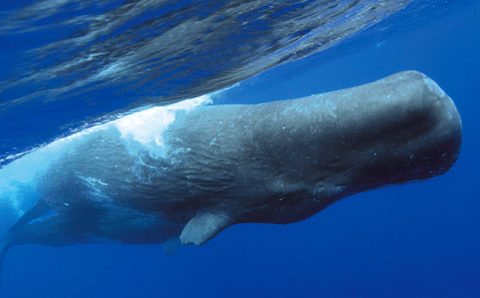
It’s believed that the head of sperm whales contains many of the necessary organs needed for echolocation (Beluga whales have similar features). These specialized organs are filled with an oil called spermaceti, which was used for manufacturing candles and other oil-based products. However, it’s also been theorized that sperm whales have padded heads due to headbutting behaviors, though more research is needed.
Another fish with a unique forehead is the barreleye fish. It is a small deep sea fish with a transparent head. The head and forehead are transparent, which allows the eyes to collect more light. These are adaptions that help them find food in the deepest parts of the ocean.
Top 15 Fish With Big Foreheads
Here are some of the most recognizable fish with big forehead modifications and why they have them. Some of these species can be found in the aquarium hobby, but many are too large to keep inside a closed environment.
1. Flowerhorn Cichlid

- Family: Cichlidae family
- Scientific name: Hybrid
- Size: 8-16 inches
- Water type: Freshwater
- Aquarium friendly? Yes
The flowerhorn cichlid is a hybrid cichlid species bred for its incredible colors and body modifications. One of these modifications is the large bump on these fish’s heads, which gives way to the flowerhorn fish name.
This ornamental bump is called a nuchal hump. Male flowerhorn fish have much more pronounced humps than females, though their exact size varies depending on stress levels, nutrition, and genes. This hump is mainly used for attracting mates and asserting dominance over other males but has also been theorized to store nutrients.
2. Red Devil
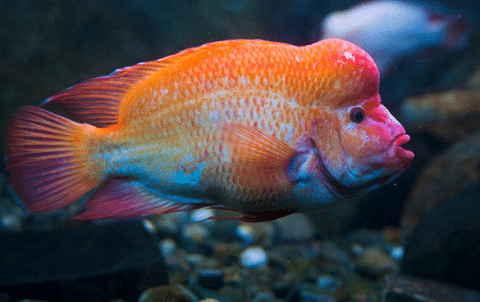
- Family: Cichlidae family
- Scientific name: Amphilophus labiatus
- Size: 10-12 inches
- Water type: Freshwater
- Aquarium friendly? Yes
The red devil is another type of cichlid with a strong forehead. These are cichlids, naturally found in Central America, specifically around Nicaragua and in the san juan river. This fish shares a common name with Amphilophus citrinellus, also known as the Midas cichlid, which can make picking out the right fish confusing.
Interestingly, wild A. labiatus individuals feature large lips. When in captivity, red devil lips greatly diminish in size. While this body modification can vary, red devils still keep a prominent forehead both in and out of the aquarium setting.
It is believed that these large heads are used for sexual dimorphism, mating, defense, and possibly protecting fry as these cichlids are excellent parents. There is also a possibility that this head is used to help the fish control its buoyancy.
3. Frontosa

- Family: Cichlidae family
- Scientific name: Cyphotilapia frontosa
- Size: <1 foot
- Water type: Freshwater
- Aquarium friendly? Yes
The frontosa cichlid, also known as the front cichlid, is a large fish with a big head to match. Even more so, the alternating black and blue stripes of these fish help accentuate an already large forehead.
Like the other cichlids on this list, frontosa may use their head for sexual dimorphism, mating, and defense. This defense is in regards to maintaining territory and resources, but may also aid in protecting these fish from other predators throughout Lake Tanganyika in East Africa.
4. Redhead Cichlid
- Family: Cichlidae family
- Scientific name: Vieja melanurus
- Size: 12-14 inches
- Water type: Freshwater
- Aquarium friendly? Yes
Not only does the redhead cichlid have a large forehead, (video source) but these fish also have a bright purplish-red face that can’t be missed in the home aquarium. The redhead cichlid originates from Central America, specifically throughout Mexico, Guatemala, and Belize.
As one of the most colorful cichlids available, these large fish were used to create some of the most popular aquarium hybrids, like blood parrot cichlids and flowerhorn cichlids. That means that they use their nuchal hump to attract mates, defend their territory, and possibly store nutrients.
5. Midas Cichlid
- Family: Cichlidae family
- Scientific name: Amphilophus citrinellus
- Size: 8-10 inches
- Water type: Freshwater
- Aquarium friendly? Yes
Not to be confused with the red devil (Amphilophus labiatus), the Midas cichlid is a very aggressive fish that uses its large forehead to defend its territory, which often encompasses the entirety of the tank. Midas cichlids likely use their hump to attract mates as well (video source).
In the wild, Midas cichlids have a less prominent hump that only appears during the breeding season. In the aquarium, fish are selectively bred for more extreme color and body modifications.
6. Tapajos Orange Head Geophagus
- Family: Cichlidae family
- Scientific name: Geophagus sp. ‘orange head’
- Size: 8-10 inches
- Water type: Freshwater
- Aquarium friendly? Yes
The Tapajos orange head Geophagus hasn’t yet been designated a cichlid scientific species, but it’s believed these fish are derivations of Geophagus brasiliensis.
These Geophagus don’t have the largest foreheads on this list but are popular aquarium fish due to their bright red face. Dominant males are especially likely to form nuchal humps and brighter colors as the fish ages.
7. Chocolate Cichlid
- Family: Cichlidae family
- Scientific name: Hypselecara temporalis
- Size: 10-12 inches
- Water type: Freshwater
- Aquarium friendly? Yes
Not much is known about the chocolate cichlid (video source). They belong to a small group of cichlids that originate from the Amazon basin in South America. While their colors aren’t the desired bright blue or red, these fish bring unique natural tones to the aquarium, which has increased their popularity over the years.
Chocolate cichlids are unique in that they don’t have an enormous forehead. Instead, they have a very broad and round head, which likely aids in their ability to find and hunt for food while also attracting mates.
8. Rio Grand Cichlid (Texas Cichlid)
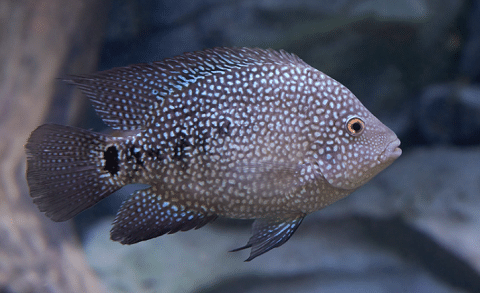
- Family: Cichlidae family
- Scientific name: Herichthys cyanoguttatus
- Size: 10-12 inches
- Water type: Freshwater
- Aquarium friendly? Yes
Also known as the Texas cichlid, the Rio Grand cichlid is the only native cichlid fish species in the United States. They are used as sporting fish and aquarium fish. They are also a popular local dish.
The Rio Grand cichlid does not have an overly pronounced forehead, but males may develop one if they gain dominance over a certain territory or group.
9. Green Terror
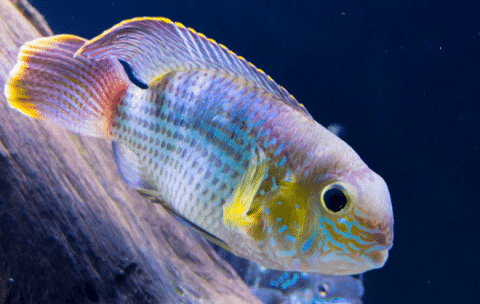
- Family: Cichlidae family
- Scientific name: Andinoacara rivulatus
- Size: 4-12 inches
- Water type: Freshwater
- Aquarium friendly? Yes
The green terror is one of the most popular fish species available in the aquarium hobby. These fish are big and colorful. Their aggression varies on an individual basis, which allows them to be kept with a variety of fish.
Like other large cichlids, the green terror has a nuchal hump, most obviously seen on dominant male fish. This hump may also be used to attract females, which are much smaller in size, as well as to aid in feeding and defending territory.
10. Asian Sheepshead Wrasse
- Family: Labridae family
- Scientific name: Semicossyphus reticulatus
- Size: 3-4 feet
- Water type: Saltwater
- Aquarium friendly? No
Far from being the prettiest fish species on this list, the Asian sheepshead wrasse definitely makes an impression in more ways than one (video source).
In addition to a large jaw and big teeth, the Asian sheepshead wrasse has a perfectly round pink egg on its head. This hump has yet to be closely studied, but it’s safe to assume that it helps the fish attract mates and defend recourses.
Like most wrasse fish species, the Asian sheepshead wrasse can change between having male and female organs throughout its life depending on environmental factors.
11. Green Humphead Parrotfish
- Family: Scaridae family
- Scientific name: Bolbometopon muricatum
- Size: 3-5 feet
- Water type: Saltwater
- Aquarium friendly? No
Also known as the bumphead parrotfish, the green humphead parrotfish is a giant saltwater fish with a giant forehead.
Interestingly, green humphead parrotfish do not display large differences in sexual dimorphism, meaning that both the males and females have a very similar appearance, including their humpheads. This would imply that the main uses of their hump is less for attracting mates, and more so for defending resources and foraging. It’s believed that green humphead parrotfish may use their nuchal hump to break up coral reefs, which are their main source of food.
These fish have a few other unique features about them, including large scales and a powerful crushing beak.
12. Mahi Mahi

- Family: Coryphaenidae family
- Scientific name: Coryphaena hippurus
- Size: <7 feet
- Water type: Saltwater
- Aquarium friendly? No
Mahi Mahi, also known as dolphinfish, is a very common commercial fish. These are long, impressive fish that don’t look like any other fish species. One of their defining features is their vertical forehead that curves into their long dorsal fin and scissor shaped tail fin.
Mahi Mahi are very fast swimmers that are apex predators. However, they’re also prey for many larger, faster fish. Their overall slender body shape, including their head, allows these fish to quickly and expertly cut through the water to either catch prey or avoid predators.
Male Mahi Mahi fish also have greater accentuated heads which can mean their appearance is used for attracting mates.
13. Oranda Goldfish
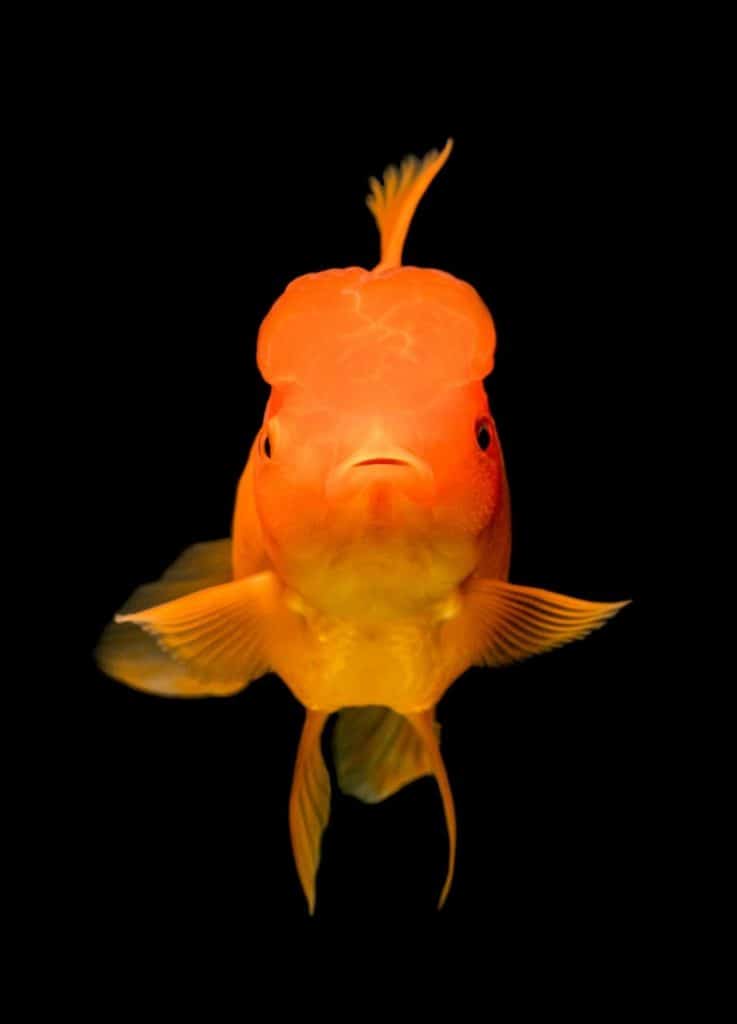
- Family: Cyprinidae family
- Scientific name: Carassius auratus
- Size: 7-9 inches
- Water type: Freshwater
- Aquarium friendly? Yes
Goldfish are some of the most recognizable fish in the aquarium hobby. These are not naturally occurring fish in freshwater habitats, but rather, have been bred for centuries to achieve the most desired colors and body modifications.
One of these modifications is the wen, or an often-colorful head cap commonly seen on ornate breeds of goldfish. This growth was initially a mutation that was later selectively bred for its unique appearance.
Oranda goldfish can have large, bubbly wens that cover the entire topside of their head. One of the most popular types of oranda goldfish is the red cap oranda, with a bright orange or red cap against a pure white body.
Unfortunately, these head growths are delicate and can easily become damaged or infected with improper care.
14. Napoleon Wrasse
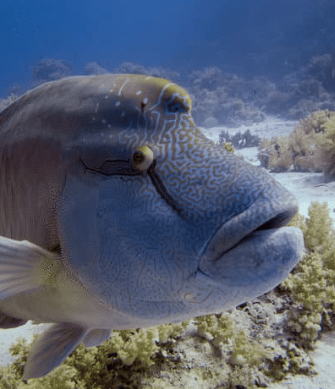
- Family: Labridae family
- Scientific name: Cheilinus undulatus
- Size: 3-6 feet
- Water type: Freshwater
- Aquarium friendly? No
Similar to the Asian sheepshead wrasse, the Napoleon wrasse also has a strong forehead. These marine fish live in and around coral reefs and are very opportunistic feeders of small crustaceans and other invertebrates.
In addition to its thick lips, the Napoleon fish may also use its big head to attract mates. The hump is likely used to defend territory.
Sadly, the Napoleon wrasse is endangered throughout the Indo-Pacific region.
15. Hump Headed Blenny
- Family: Blenniidae family
- Scientific name: Blenniella gibbifrons
- Size: 2-4 inches
- Water type: Saltwater
- Aquarium friendly? No
Not all fish with big heads need to be big. The hump headed blenny, also known as the bullethead rockskipper, is a small fish from the Indian and Pacific Oceans that hasn’t really been studied.
That being said, almost all blennies have high-mounted eyes on the tops of their head that allow them to spot prey on the substrate or rock floor while also being alert to passing predators. This accentuated hump may help these blennies find prey and avoid predators better altogether.
FAQs
What is the name of the fish that has a big head?
There are many fish with a big head! In the aquarium hobby, the flowerhorn fish is thought to have some of the biggest heads possible as they have been selectively bred for decades. In the wild, humphead wrasses have some of the most prevalent head features.
What is the big fish with a bulbous head?
When talking about not only big heads but also bulbous heads, fancy goldfish are at the top of most hobbyists’ lists. Some breeds of goldfish have bubbly head caps that have been selectively bred for generations.
Why do some fish have big foreheads?
Fish have large foreheads to better aid in survival. This could be for mating, defensive, and foraging purposes.
What kind of fish is Yoriko?
Yoriko is another common name for the Asian sheepshead wrasse.
What is the Japanese big forehead fish?
The most well-known species of a big foreheaded fish in the western Pacific Ocean is the Asian sheepshead wrasse. These fish are native to tropical waters around Japan, China, and the Korean peninsula.
What are the goldfish with big heads called?
The oranda goldfish is one of the most common breeds of big-headed goldfish. The lionhead goldfish also has a smaller wen head cap.
Conclusion
While a big forehead doesn’t make a fish smarter, these body structures can help fish survive in their natural habitats. Big foreheads can impress mates while allowing individuals to guard themselves and their resources. There is also a lot of speculation about how these modifications could further help fish store nutrients, maintain buoyancy, and even aid in better echolocation of each other and prey.
If keeping a fish with an enhanced forehead, make sure to take special care that it does not get damaged, as infection can easily spread.
- About the Author
- Latest Posts
I’m thrilled that you found Aquarium Store Depot! Here you’ll find information on fish, aquariums, and all things aquatics related. I’m a hobbyist (being doing this since I was 11) and here to help other hobbyists thrive with their aquariums! I adhere to a high quality Editorial Process and Review products with real life field usage and practical analysis.

